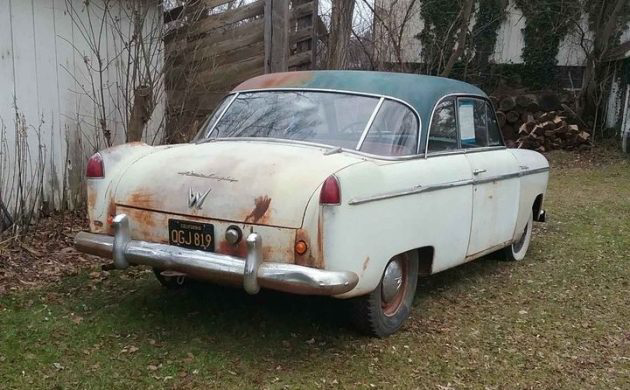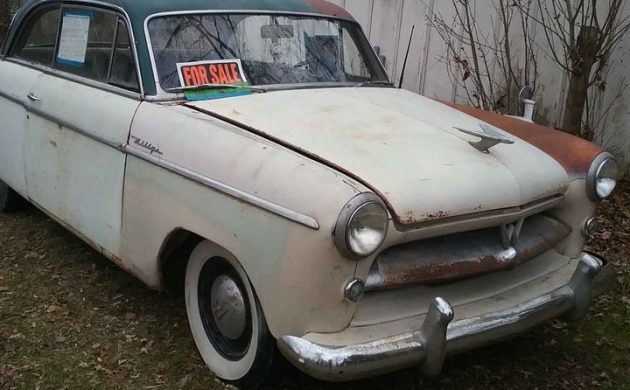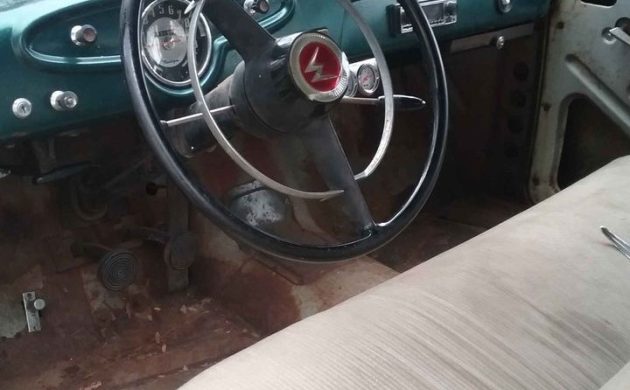
When you think you the Willys brand, you likely have visions of the venerable Jeep that was built in huge numbers during and after World War II. But they were also in the automobile business for a time, including the compact Willys Aero. This example from 1953 has had a restoration started, but more work will be needed, especially with exterior cosmetics. Located in Davisburg, Michigan, this small 2-door hardtop is part of the Eagle series with a “Hurricane” six-cylinder engine. This project vehicle is available here on Facebook Marketplace for $3,950 OBO. Barn Finder “Ted” is credited with this tips alert!

Once pent-up demand for new automobiles was satisfied after WW2, car manufacturers started to turn their attention to another market segment – the “second car.” Those were for families who needed a second vehicle but not necessarily one as big or as fancy as the primary. Enter the “compact” of which the Willys Aero was one of many that started to materialize in the 1950s. It was produced in some variations from 1952 to 1955 when the company decided their time and money were better spent on their core business, off-road vehicles. But the Aero would enjoy success well into the 1960s by being produced and sold in Brazil.

The seller’s Aero is one of more than 91,000 that were built in Willys’ Toledo, Ohio plant before they got out of the compact car market. No history of the machine is provided other than it originated in California and eventually found its way to Michigan. Because it’s the more desirable hardtop, it would be an Aero Eagle, the only series to offer that body style. The seller says a restoration has been started which focused on the mechanical side of things, including a new suspension, brakes, and a conversion from a 6V to 12V electrical system.

Under the hood resides Willy’s “Hurricane” six-banger with a 3-speed manual transmission, both of which could have as little as 39,000 miles. But no mention is made if the car is highway-capable at this stage. So, we’ll assume the remaining work will be more of a cosmetic nature, including the paint and possibly the interior. The seller will consider a trade and is specifically looking for a 1980s Chevy El Camino or Malibu station wagon. Would you take this plunge on this Willys project?

Doing the comment thing again, I’ll show you, 1 sentence at a time,,
Regarding the banner headline, well, yes and no on the Jeep thing,
Okay, I think it’s safe now, while not marketed as a Jeep, Willys was riding high on the Jeep, and the Willys cars shared that limelight. This was the car Joe Lunchpail drove the 4 miles to the factory, 3.5 miles after work to the local tavern, and hopefully, the .5 miles home. A bit on the pricey side, I read this car cost around $1700 new, when a base Ford Mainline was about $300 less. The Aero was actually quite popular in Ramblertown, for obvious reasons, I think my old man had one for a spell. These were simple cars, most of us backyard mechanics cut our teeth on cars like this, and you know, life was good. These are the cars that owners worked for the guy with the black Cadillac.
And submit, again, I guess that problem is a BFs staple.
GM and Ford had a brutal sales/price war in the fifties, and they drove the prices of full-sized Fords and Chevys to within hundreds dollars of the “compact” Willys, Studebakers, and Nashes, driving their offerings out of the market and their companies into mergers.
Tucker was the only company NOT driven out of business by the “Big Three,” everyone else, Kaiser, Willys, Studebaker, etc, was.
Here’s one that is not even really a project. Plus, it has overdrive. https://boise.craigslist.org/cto/d/trout-creek-price-reduced-1952-willys/7741188575.html
It’s not a Hardtop.
Actually, Willys was on the verge of bankruptcy…and it would have been their second trip through, in 20 years. That was the whole reason Henry Kaiser got mixed up with them – Kaiser-Frazer was on the rocks, financially, but the parent company, Kaiser Industries, was healthy. Kaiser’s partner in K-F, Joe Frazer, had jumped ship, and K-F was in many of the same struggles. Neither Kaiser nor Willys management (I believe, Charlie Sorenson by then) understood the postwar consumer auto market.
Prior to Kaiser Industries involvement, Willys was a reluctant vendor of the Jeep. They had put together a demonstrator by invitation, but the idea wasn’t theirs – it was out of American Bantam. Ford wanted in but Willys desperately NEEDED in. As did Bantam – but Bantam wasn’t Too Big To Fail.
So Willys under Sorenson continued MB contracts, as well as the Willys station wagon and Jeepster…but they really wanted to finally return to the passenger-car market, where the honor and glory lay.
It wasn’t to be. Henry Kaiser saw their troubles; saw he could buy out the stockholders. And Henry didn’t understand consumer autos, but he DID understand government contracts. He saw a chance to make an honorable exit of K-F (selling the tooling to his new Argentine subsidy) and focus on Jeeps and military trucks.
And he figured correctly. For the next 16 years, military supplies were the backbone of Willys, renamed Kaiser-Jeep. Civilian utility derivatives rounded out the product line, until the J-Series (Wagoneer and Gladiator) emerged in 1962.
But the Willys Aero (some histories call it the Aero Willys) was a casualty, and Willys was to lose its identity behind the Jeep brand.
I think you have it backwards, Willys Overland was healthy financially, they had the funds to manufacture the Aero after all. It was Kaiser that was bankrupt, if not for the Reconstruction Finance federal loan to Kaiser (contingent on their production of the Henry J), Kaiser would have quit in 1950 without that loan. Then of course it’s peculiar how Kaiser was able to purchase Willys in 1953! Done through stock exchanges and other loans.
My readings, and I’ve read several sources, state otherwise.
K-F was in the same situation Willys was in; but the parent company, Kaiser Industries (owning Kaiser Aluminum, Kaiser Steel, Kaiser Permanente, Kaiser Shipbuilding) was solvent.
The end for K-F came when its bank refused further credit without securities outside the auto operation. Henry Kaiser was hard-charging and sometimes reckless, but he was no fool. He declined and sought another way.
Willys-Overland, on the other hand, was running on a shoestring. Why it didn’t profit from MB sales in the war, I don’t know; but the whole reason for the odd Basket-Weave wagon was, Willys was reduced to using stamping presses originally intended for a washing-machine manufacturer. The presses were limited in how deep they could stamp. Brooks Stevens was commissioned to make a design based on that limitation, and the Station Wagon came of it.
IIRC, the Aero body was made under contract. May have been Briggs, I don’t recall.
new battery cables … sign me “down
Looks like a Hillman of the same vintage. Or a Rambler.
I think it’s worth every penny. It’s something you don’t see every day. And those were pretty good motors. If it doesn’t sell I would be very surprised.
I agree with Timothy… reasonable looking car that you don’t see every day… bulletproof driveline on these… Don’t know how easy body/interior parts are to find though.Nice article Russ
I had one just like this one in the mid 80s that I bought to fix up for my daughter to drive in high school. I found a four door parts car to contribute some missing bits. Unfortunately my daughter wasn’t impressed so we bought her an MGB instead. Sold both the Willys but was disappointed that I didn’t continue the project. Another one that got away.
I had one in the late 60’s. Drag car with 426 Chrysler wedge. Hillborn injection, Dempsey Wilson solid lifter cam. 12.5 to 1 pistons, hemi manual shift torqueflight trans, Ford 9 inch rear end with 4:30 locker; Best times were in the 10.30’s @ 136 MPH. Loved racing it, but couldn’t afford the expense every weekend. Still miss that ride.
“Back in the day”, I owned 2 different Willys Aero cars. Born in and living in Toledo, it kind of made sense.
One was a clapped-out 55 Custom (4dr) rust bucket $50 car that I drove for about a year before I gave up on it (“gave up” means found something better). Actually found someone who paid me $75 for it – $25 profit! Wonder if the chewing gum patch on the fuel line ever caused a problem…
Other was a 53 Aero Lark. Purchased in the first awful throes of the 73 oil embargo, when I determined my college part-time job could not support the gas-hungry 55 Patrician I was using daily. Found it sitting in front of a barn in a farmer’s lot, on the way to a swap meet one Saturday. Just sitting – no for sale sign. Stopped on the way back, and “Yeah, I guess it might be for sale. I’ll check with my brother.” It had been stored “inside” (I guess 3 walls around and a roof over constitutes inside) for those 11 years, not touched, and just pulled outside the week before. Turns out the mileage WASN’T the 102,571 I thought, but actually 2,571 (without the 100,000). The brother was not quite right in the head, I guess, and had determined there was something wrong with the engine, so drove it very little for some years, then parked it in 1962, according to the rusty license plate on the front bumper. Price turned out to be a whopping $250. One good cleanup, a full brake job, and tow it back and forth till the engine rotated ok, tune-up, and it was back in business with nothing at all wrong with the engine.
Sold that Lark to a friend of a few years – he was the guy who bought out the factory-stock of NOS parts when Willys cleared out the factory several years after discontinuing the Aero. He had every single piece of NOS to put on the car to replace the weathered chrome, and kept winning prizes with it for several years at shows.
As to history of the Willys Aero, JustPassinThru nailed it pretty good – can’t think of anything more to add.
HA! DISCOVERED another rare-as-hen’s- teeth Italian car part. Not unlike the rear tail lamps on a 59* Cadillac, or the same on a similar vintage Hudson Hornet these complete Willies rear tail lamps likely were the choice of Gila fitting the front corners of a converted Chrysler 300 “Dual Gila” as a near one-off custom show car. I have been looking for these for years! likely the ones. NOW–just as rare-likely.
I’m familiar with the usual places for these cars to rust, and I don’t see any. With what looks like the original paint, this body looks to be exceptionally nice. I see surface rust on the floor, can’t tell if any rust through, but would be an easy repair at any rate. This car is well worth the money and will make someone a great collector car.
My first car in 1958 was a Willys Aero
Two door hardtop. Great little car.
I got hit by a drunk driver and car was
Totaled.
Greg Hoover is right, the $7000 one in Idaho is the better deal. These cars really do need the overdrive option.
Michigan spells RUST, better do an inspection unless you like welding and fabricating.
$7000 one is not hardtop.